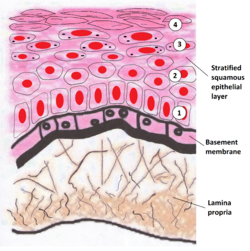Basement membrane
| Basement membrane | |
|---|---|
 The epithelium and endobasement membrane in relation to epithelium and endothelium. Also seen are other extracellular matrix components | |
 Image showing the basement membrane of the lining of the mouth, which separates the lining (epithelium) from a loose layer of connective tissue (the lamina propria) | |
| Details | |
| Identifiers | |
| Latin | membrana basalis |
| MeSH | D001485 |
| TH | H2.00.00.0.00005 |
| FMA | 63872 |
| Anatomical terms of microanatomy | |
The basement membrane, also known as base membrane, is a thin, pliable sheet-like type of extracellular matrix that provides cell and tissue support and acts as a platform for complex signalling.[1][2] The basement membrane sits between epithelial tissues including mesothelium and endothelium, and the underlying connective tissue.[3][4]
Structure


As seen with the
The basal lamina layer can further be subdivided into two layers based on their visual appearance in electron microscopy. The lighter-colored layer closer to the epithelium is called the
To represent the above in a visually organised manner, the basement membrane is organized as follows:
- Epithelial/mesothelial/endothelial tissue (outer layer)
- Basement membrane
- Basal lamina
- Lamina lucida
- Lamina densa
- collagen IV (coated with perlecan, rich in heparan sulfate)
- Attaching proteins (between the basal and reticular laminae)
- collagen VII(anchoring fibrils)
- fibrillin (microfibrils)
- Lamina reticularis
- reticular fibers)
- Basal lamina
- Connective tissue (Lamina propria)
Function
The primary function of the basement membrane is to anchor down the epithelium to its loose connective tissue (the dermis or lamina propria) underneath. This is achieved by cell-matrix adhesions through substrate adhesion molecules (SAMs).
The basement membrane acts as a mechanical barrier, preventing
The basement membrane is also essential for
The most notable examples of basement membranes is the
As of 2017, other roles for basement membrane include blood filtration and muscle homeostasis.[1] Fractones may be a type of basement membrane, serving as a niche for stem cells.[10][11]
Clinical significance
Some diseases result from a poorly functioning basement membrane. The cause can be genetic defects, injuries by the body's own immune system, or other mechanisms.[12] Diseases involving basement membranes at multiple locations include:
- Genetic defects in the collagen fibers of the basement membrane, including Alport syndrome and Knobloch syndrome
- Goodpasture's syndrome.[13]
- A group of diseases stemming from improper function of basement membrane zone are united under the name epidermolysis bullosa.[14]
In
Evolutionary origin
These are only found within
See also
- Tunica intima – Inner layer of blood vessel
References
- ^ PMID 28040522.
- PMID 29853176.
- ISBN 978-0-323-07842-9.
- ^ ISBN 9780470646083.
- from the original on 2007-10-13.
- PMID 1744087.
- S2CID 4356057.
- PMID 3049626.
- ^ "Sect. 7, Ch. 4: Basement Membrane". Renal Physiology Glomerular Filtration Rate and Renal Blood Flow. Medical College of Georgia, Robert B. Greenblatt, M.D. Library. 1 April 2008. Archived from the original on 1 April 2008. Retrieved 7 May 2018.
{{cite book}}: CS1 maint: bot: original URL status unknown (link) - S2CID 19919800.
- PMID 30379609.
- ^ Henig RM (February 22, 2009). "What's Wrong With Summer Stiers?". New York Times. Archived from the original on November 9, 2016.
- ISBN 978-0-8153-3642-6.
- S2CID 221861310.
- PMID 11048985.
Further reading
- Kefalides NA, Borel JP, eds. (2005). Basement membranes: cell and molecular biology. Gulf Professional Publishing. ISBN 978-0-12-153356-4.
